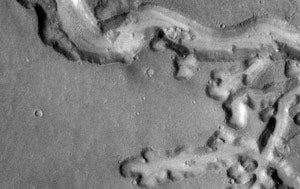
Valley Networks
Mars is home to tens of thousands of valleys, with a combined length of nearly a million kilometers. Some have interpreted the valley networks as evidence that the planet was once warmer and wetter than it is now.
Photo: NASA/JPL/ASU
X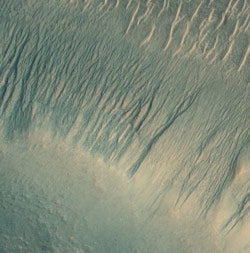
Gully Clusters
Gullies are small Martian landforms identified in imagery from a camera on NASA’s orbiting Mars Global Surveyor. Generally occurring on slopes, and sometimes showing changes over just a few years, gullies may be evidence for recent—if not extant—liquid water on Mars.
Photo: NASA/JPL/University of Arizona
X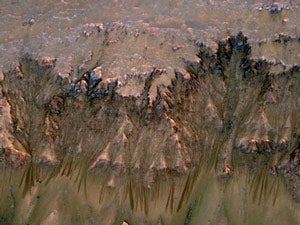
Seasonal Markings
The Mars Reconnaissance Orbiter has spotted tendril-like surface features known as recurring slope lineae, which appear in spring, extend gradually downhill, and then fade in summer or fall. They could be the sign of briny liquid water flowing just below the surface.
Photo: NASA/JPL/University of Arizona
X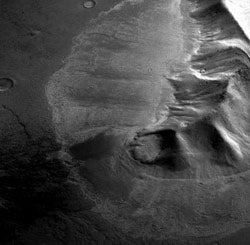
Buried Glacier
Radar soundings from the Mars Reconnaissance Orbiter showed in 2008 that debris-coated landforms on Mars are massive glaciers of nearly pure water ice. One of the glaciers studied is roughly three times the size of Los Angeles.
Photo: ESA/DLR/FU Berlin
X
Phoenix
NASA’s Phoenix lander operated in the Martian arctic from May to November 2008. The lander conducted chemical analyses of Martian soil and confirmed that frozen water exists just below the surface.
Photo: NASA/JPL-Caltech/University of Arizona/Texas A&M University
XMars 3
The U.S.S.R. scored the first soft landing on Mars in December 1971 with this probe. The Mars 3 functioned for mere seconds, however, before ceasing communication.
XMars 2
This Soviet lander crashed in November 1971, becoming the first man-made object to reach the Martian surface.
X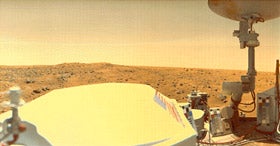
Viking 1
The first of two Viking landers touched down in July 1976 on the plains of Chryse Planitia and examined the Martian surface until 1982. NASA’s Vikings looked for evidence of life in the soil.
Photo: NASA
X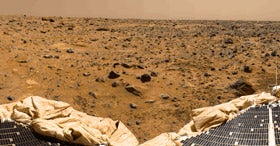
Pathfinder/Sojourner
The Pathfinder lander reached Mars on July 4, 1997, bouncing into a valley called Ares Vallis on an airbag cushion. It soon deployed the tiny Sojourner rover, the first successful use of a mobile craft on Mars, to explore the surroundings and make chemical analyses of nearby rocks.
Photo: NASA
X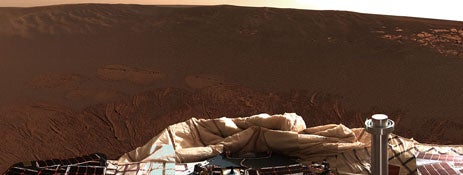
Opportunity
One of two twin rovers to arrive at Mars in 2004, Opportunity is still exploring the Red Planet. Originally tapped for a 90-day mission, Opportunity has lasted more than seven years and has logged more than 30 kilometers exploring the many craters of Meridiani Planum.
Photo: NASA
XMars 6
This lander collected data on the tenuous Martian atmosphere for about four minutes during its March 1974 descent but then fell silent. Mars 6 presumably crashed into the Margaritifer Sinus region.
XBeagle 2
The U.K.-led Beagle 2 project was to deliver a small lander to the Isidis Planitia, a plain inside a large impact basin. But no signals from Beagle 2 were detected after the lander was released from the European Space Agency’s Mars Express orbiter on December 19, 2003, on a ballistic trajectory toward Mars.
X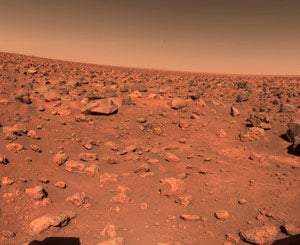
Viking 2
This NASA lander touched down on the plains of Utopia Planitia in September 1976 and remained operational until 1980. Two twin Viking landers looked for possible signs of life but found the soil to be desiccated and sterile.
Photo: NASA
XCuriosity
NASA’s king-size rover, also known as the Mars Science Laboratory, is scheduled to launch in November and touch down in August 2012. Curiosity will explore Gale Crater, an impact basin with a tall interior mound and indications of past hydrologic activity.
X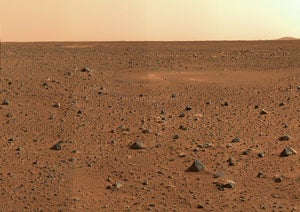
Spirit
Like its twin rover Opportunity, Spirit greatly outlived its three-month warranty after landing in January 2004. Spirit explored Gusev Crater before the rover became stuck in soft soil in 2009 and finally succumbed in 2010.
Photo: NASA
XMars Polar Lander
This NASA probe was lost in December 1999 after mission controllers sent it on a trajectory toward a landing in the south polar region. An investigation found that the lander may have prematurely shut down its descent engines and crashed into the surface.
X